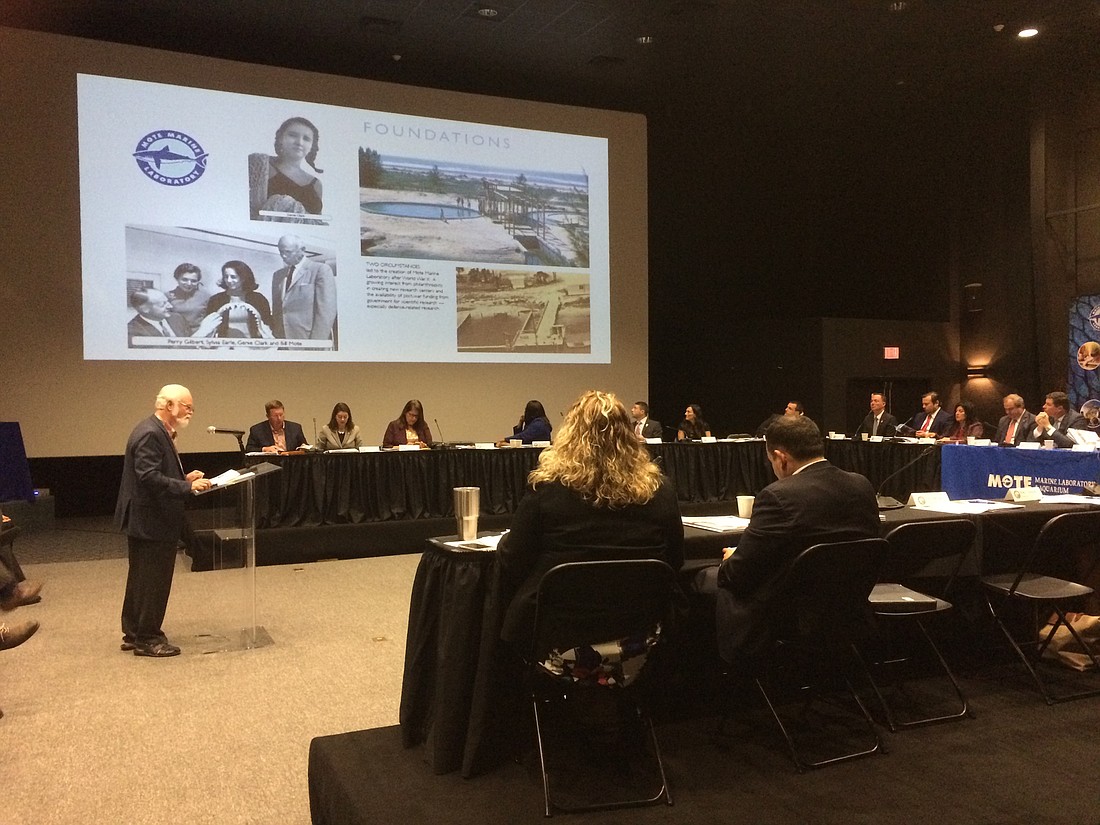- April 15, 2024
-
-
Loading

Loading

Members of the Bay Area Legislative Delegation, consisting of 38 state lawmakers from eight counties surrounding Tampa Bay, voted unanimously Tuesday to make funding the Red Tide Institute at Mote Marine Laboratory a top priority of the delegation in the upcoming legislative session.
After listening to two-and-a-half hours of presentations on red tide, transportation and the Bay area’s economic competitiveness, Sen. Joe Gruters, R-Sarasota, proposed a motion to the 25 lawmakers attending that the delegation back Mote’s efforts to develop red tide mitigation technologies. The motion came in response primarily to Mote Marine CEO Dr. Michael Crosby’s opening presentation Tuesday morning in the WAVE Center auditorium at Mote Marine.
Crosby urged the lawmakers to commit to five years of consistent funding at $3 million a year so Mote’s scientists can complete the development of red tide technologies. “I am convinced we can develop mitigation technologies that can reduce the effects of red tide,” he told them.
“It’s very simple to kill red tide,” Crosby said, noting at one point that he could load crop dusters with chemicals and spray the algae blooms in the Gulf of Mexico and kill them “lickety split.”
“But the key is to develop technologies that do no greater harm to the environment,” he said.
“We can do this,” Crosby said emphatically to the group. “But,” he said, pausing. “When red tide goes up, funding goes up. When red tide goes down, funding goes down. We need consistent funding.”
“Give us five years — five years — and we will develop these technologies,” he said.
Crosby told lawmakers Mote and other scientists have developed many technologies that can mitigate and control the effects of red tide, but they are not ready to be deployed in large areas and need more development and research.
Crosby cited the $1 million contribution to Mote from the Andrew and Judith Economos Charitable Foundation to create the Red Tide Institute as a key ingredient to developing the mitigation technologies.
But he urged the Legislature also to support the institute’s efforts. “This is something we must do together,” he said.
Crosby reminded the lawmakers red tide is not caused by humans. “Even if we shipped everyone [in Florida] to Texas, we’d still have red tide,” he said. In contrast, the blue-green algae in Florida’s inland waterways “is related to human actions” affecting Lake Okeechobee and “really needs to be dealt with.”
Following Crosby, the lawmakers also heard presentations from:
• Eric Sutton, executive director of the Florida Fish and Wildlife Conservation Commission, on red tide.
• David Green, executive director of the Tampa Bay Area Regional Transportation Authority, on the region’s future transportation needs.
• Rick Homans, CEO of the Tampa Bay Partnership, on the region’s economy and economic competitiveness.
While Green and Homans noted the Tampa Bay region’s continued population growth as a positive to the regional economy, they both presented data showing trends that will add to congestion and that the region needs to improve its workforce competitiveness.
Citing a recent study on the region’s competitiveness compared to 19 other U.S. metropolitan regions, Homans said: “We ranked at or near the bottom of every talent indicator.”
Chaired by Senate President Bill Galvano, R-Bradenton, the Bay Area Legislative Delegation includes all lawmakers from Sarasota, Manatee, Pinellas, Hillsborough, Pasco, Hernando, Citrus and Polk counties. Together, these lawmakers represent nearly 25% of the Legislature’s members.